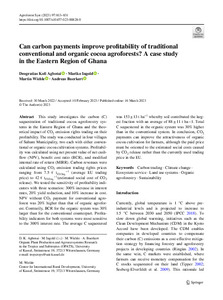| dc.date.accessioned | 2023-08-14T14:04:32Z | |
| dc.date.available | 2023-08-14T14:04:32Z | |
| dc.date.issued | 2023-03-16 | |
| dc.identifier | doi:10.17170/kobra-202308018553 | |
| dc.identifier.uri | http://hdl.handle.net/123456789/14988 | |
| dc.description.sponsorship | Gefördert im Rahmen des Projekts DEAL | ger |
| dc.language.iso | eng | |
| dc.rights | Namensnennung 4.0 International | * |
| dc.rights.uri | http://creativecommons.org/licenses/by/4.0/ | * |
| dc.subject | carbon trading | eng |
| dc.subject | climate change | eng |
| dc.subject | ecosystem service | eng |
| dc.subject | land use system | eng |
| dc.subject | organic agroforestry | eng |
| dc.subject | sustainability | eng |
| dc.subject.ddc | 630 | |
| dc.title | Can carbon payments improve profitability of traditional conventional and organic cocoa agroforests? A case study in the Eastern Region of Ghana | eng |
| dc.type | Aufsatz | |
| dcterms.abstract | This study investigates the carbon (C) sequestration of traditional cocoa agroforestry systems in the Eastern Region of Ghana and the theoretical impact of CO₂ emission rights trading on their profitability. The study was conducted in four villages of Suhum Municipality, two each with either conventional or organic cocoa cultivation systems. Profitability was calculated using net present value of net cashflow (NPV), benefit cost ratio (BCR), and modified internal rate of return (MIRR). Carbon revenues were calculated using CO₂ emission trading rights prices ranging from 7.5 € tCO2eq.−1 (average EU trading price) to 42 € tCO2eq.−1(estimated social cost of CO₂ release). We tested the sensitivity of profitability indicators with three scenarios: 300% increase in interest rates, 20% yield reduction, and 10% increase in cost. NPV without CO2 payment for conventional agroforest was 20% higher than that of organic agroforest. Contrarily, BCR for the organic system was 30% larger than for the conventional counterpart. Profitability indicators for both systems were most sensitive to the 300% interest rate. The average C sequestered was 153 ± 13 t ha−1 whereby soil contributed the largest fraction with an average of 88 ± 11 t ha−1. Total C sequestered in the organic system was 30% higher than in the conventional system. In conclusion, CO₂ payments can improve the attractiveness of organic cocoa cultivation for farmers, although the paid price must be oriented to the estimated social costs caused by CO₂ release rather than the currently used trading price in the EU. | eng |
| dcterms.accessRights | open access | |
| dcterms.creator | Agbotui, Deogratias Kofi | |
| dcterms.creator | Ingold, Mariko | |
| dcterms.creator | Wiehle, Martin | |
| dcterms.creator | Bürkert, Andreas | |
| dc.relation.doi | doi:10.1007/s10457-023-00828-0 | |
| dc.subject.swd | Ghana | ger |
| dc.subject.swd | Umweltzertifikathandel | ger |
| dc.subject.swd | Nachhaltigkeit | ger |
| dc.subject.swd | Ökosystemdienstleistung | ger |
| dc.subject.swd | Landnutzung | ger |
| dc.subject.swd | Agroforstwirtschaft | ger |
| dc.subject.swd | Biologische Landwirtschaft | ger |
| dc.subject.swd | Kakao | ger |
| dc.subject.swd | Klimaänderung | ger |
| dc.type.version | publishedVersion | |
| dcterms.source.identifier | eissn:1572-9680 | |
| dcterms.source.issue | Issue 5 | |
| dcterms.source.journal | Agroforestry Systems | eng |
| dcterms.source.pageinfo | 813-831 | |
| dcterms.source.volume | Volume 97 | |
| kup.iskup | false | |


